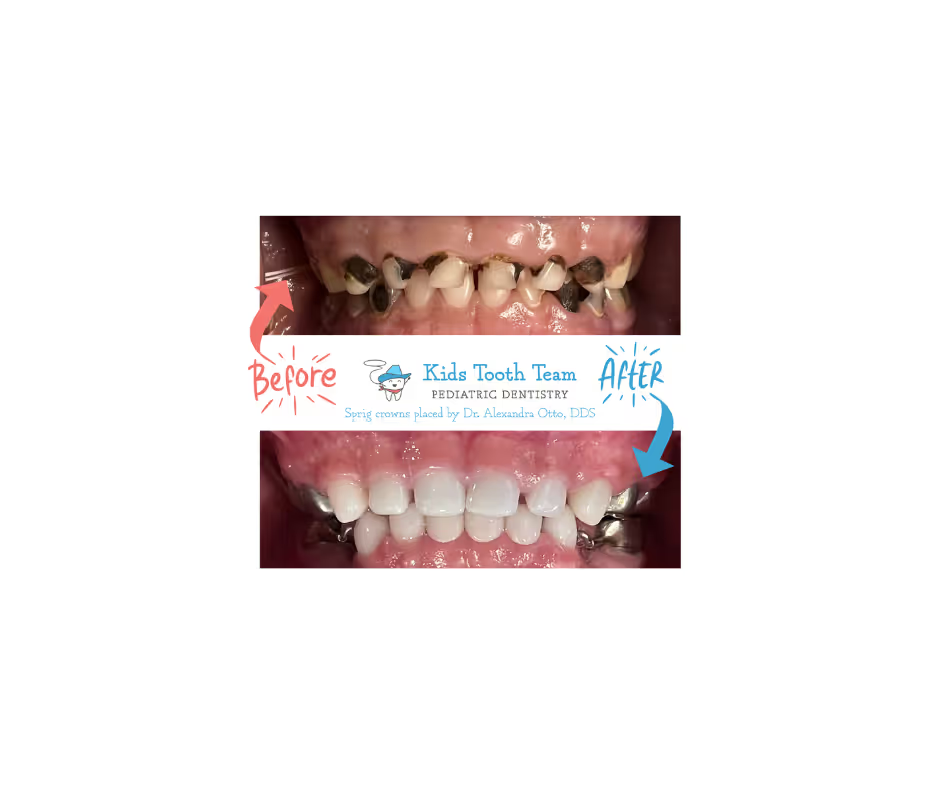
Treat a Deep Cavity
Cavities that are very deep and extensive should not be treated with fillings, as large fillings can weaken teeth. Crowns are usually a better alternative.


Restore your child's smile with pediatric dental crowns. With a variety of crowns to choose from, our Sprig-certified experts can help pick the best choice for your little one's unique needs!

A dental crown is one of the best ways to treat a tooth that has been damaged by tooth decay or a dental injury. They're actually less invasive than dental filling as we remove less of the tooth, and offer a 95% success rate. With a white or silver crown from one of the specialty trained dentists at Kids Tooth Team, you can restore your child’s bite and smile, and prevent further dental complications. Contact us for a consultation today. We have three office locations in Buda, South Austin, Kyle, and Pflugerville!
At Kids Tooth Team, we’re proud to share that every one of our doctors is a Sprig Certified Provider—meaning each has completed advanced training in Sprig Zirconia Crowns, the highest-quality white crowns available for children today.
Under the guidance of our founder, Dr. Alexandra Otto—who serves as a national Sprig Clinical Faculty Member and international speaker—our doctors receive direct mentorship and continuing education from one of the nation’s leading experts in pediatric zirconia crowns.
This collaborative approach ensures that every child in our care benefits from the same level of excellence, precision, and esthetic results, no matter which doctor they see.We’re honored to bring this level of training and innovation to our community—and to help every child smile with confidence.
In baby teeth, crowns aren’t just for big cavities—they’re often the strongest, most reliable treatment we can offer. Even when placed perfectly, fillings can break or fail 40–50% of the time, while crowns have a much higher success rate—between 95–99%. So while a crown might be necessary for a large cavity, it can also be the better option for smaller ones, especially if your child needs sedation to complete treatment. Our goal is always to minimize how many times your child needs to undergo care. The last thing we want is for your child to go through multiple procedures on the same tooth when one well-done crown could have solved the problem from the start.
%25201.avif)

Cavities that are very deep and extensive should not be treated with fillings, as large fillings can weaken teeth. Crowns are usually a better alternative.

After a nerve treatment with a pulpotomy or a pulpectomy to treat a tooth infection, a crown is the only way to cover up and protect the tooth structure.

Crowns cover and protect the entire tooth structure, making them a great option for kids who have had a tooth cracked or broken by dental trauma.
At Kids Tooth Team, we offer both silver and white crown options for any tooth that needs extra protection. Our team will walk you through the best option for your child’s needs, balancing function, aesthetics, and comfort.

Sprig Zirconia Crowns are the most cosmetic option available. Made from highly biocompatible zirconia, these crowns blend in beautifully with your child’s natural smile—so no one will ever know there was a sugar bug there!

Silver Crowns are made from nickel, chromium, and surgical-grade stainless steel. They’re a cost-effective option and provide durable, long-lasting treatment for your child’s tooth.
In baby teeth, crowns aren’t just for big cavities—they’re often the strongest, most reliable treatment we can offer. Even when placed perfectly, fillings can break or fail 40–50% of the time, while crowns have a much higher success rate—between 95–99%. So while a crown might be necessary for a large cavity, it can also be the better option for smaller ones, especially if your child needs sedation to complete treatment. Our goal is always to minimize how many times your child needs to undergo care. The last thing we want is for your child to go through multiple procedures on the same tooth when one well-done crown could have solved the problem from the start.
%25201.avif)
Cavities that are very deep and extensive should not be treated with fillings, as large fillings can weaken teeth. Crowns are usually a better alternative.
After a nerve treatment with a pulpotomy or a pulpectomy to treat a tooth infection, a crown is the only way to cover up and protect the tooth structure.
Crowns cover and protect the entire tooth structure, making them a great option for kids who have had a tooth cracked or broken by dental trauma.
Not all white crowns—or the doctors placing them—are the same. At Kids Tooth Team, we believe your child deserves the very best, and when it comes to Zirconia crowns, two things matter most: who places them, and what product they use.
If your office isn’t using Sprig and doesn’t have the training to do it right, it’s okay to ask questions—or even walk away. Your child deserves expert care and top-quality materials, and we’re here to deliver both.

Zirconia crowns require advanced training and precision, and not all pediatric dentists are trained to place them properly. Every doctor at Kids Tooth Team is certified in Sprig Zirconia Crowns—the gold standard in white crowns for kids. Our founder, Dr. Alex Otto, is one of the nation’s leading experts in this technique. She’s an international speaker and instructor for Sprig, teaching doctors around the world how to place these crowns with excellence. When you’re making this kind of investment in your child’s smile, experience matters.
Many pediatric offices cut corners by using knock-off brands to save money. At Kids Tooth Team, we only use Sprig—the premier, all-zirconia crown that’s completely biocompatible, chip-resistant, and designed to blend beautifully with your child’s natural smile. These crowns don’t just look better—they are better for your child’s long-term health and comfort.
We love welcoming new folks ‘round these parts. If you’re planning your first visit, be sure to take advantage of our new patient special. With a free second opinion consultation, we’ll make sure your little one gets started off on the right foot at our office.
If you’re looking for the best way to restore your child’s tooth after damage or decay, Sprig white crowns are the answer. These crowns are made from the highest-quality materials, and have quite a few advantages over traditional stainless steel and lesser brands of zirconia pediatric crowns.
Compared to stainless steel, zirconia is actually stronger! Sprig dental crowns use a ceramic white material that’s more resistant to the pressure and forces of biting and chewing. This means that there’s less of a risk of damage or premature crown failure if you opt for Sprig white crowns at Kids Tooth Team.
Our white crowns are made of 100% biocompatible ceramic material. This means that it’s suitable for kids who may be sensitive or even allergic to metals. With a Sprig dental crown, you can be sure that your child won’t have to worry about negative reactions to a metal dental prosthetic in their mouth.
The primary drawback of stainless steel pediatric dental crowns is their unnatural appearance. Simply put, it will be obvious that your child has a silvery-gray metal tooth. But Sprig white crowns are made of a tooth-colored ceramic material. They're hand-glazed and hand-painted for the most natural appearance possible. With a Sprig crown, your child’s tooth will look and feel completely natural.
Kids are not always the most diligent about brushing and flossing properly. That’s why Sprig white crowns are naturally resistant to the accumulation of bacteria-filled plaque. They also use special internal “retention grooves” that help ensure a tight seal around your child’s tooth, preventing further decay around the treated tooth. While you should make sure your child is brushing and flossing properly, Sprig crowns from Kids Tooth Team help give you a little extra protection from tooth decay.
To offer these white crowns, dentists must be properly trained in their placement by Sprig. This ensures that a dentist has the necessary knowledge to place crowns properly and get the best possible treatment outcome for your little one. At our office, our doctors are all Sprig-certified, so you can trust us to take great care of your little one’s teeth.
We offer multiple styles of crown to suit the needs of every little smile that walks through our doors.
At our office, we offer Sprig white dental crowns. These tooth-colored crowns are built from a natural, lifelike ceramic material. This means that Sprig crowns look and feel just like a “real” tooth. This means they're superior to stainless steel crowns, especially when it comes to restoring front teeth.
With a Sprig dental crown in South Austin, Buda, or Kyle from Kids Tooth Team, your child’s smile will look completely natural as they grow, and their tooth will be protected until it falls out and it’s replaced by their adult tooth. If you want a lifelike, metal-free restoration for your child’s damaged tooth, our Sprig-certified dentists are here to help.Dr. Alex is fully certified in the placement of Sprig white dental crowns.
Stainless steel crowns are commonly used to treat baby teeth. They are available in a variety of prefabricated sizes and shapes, and can be placed in your child’s mouth in just a single appointment, often with the minimally-invasive Hall Technique.
3M stainless steel crowns are made from the best materials making them extremely durable, especially when compared to cheaper brands used by many other dentists. This makes them perfect for treating baby teeth and protecting them until they fall out naturally as your child grows.
The Hall Technique is a method of placing a crown which involves no drilling or numbing needles. The affected tooth is simply cleaned and disinfected, and a special dental cement is used to attach a stainless steel crown directly to the tooth. Not all patients can have a crown placed with the Hall Technique, but it’s a great option for eligible kids.
Sample text is being used as a placeholder. Sample text helps you understand how real text may look. Sample text is being used as a placeholder for real text that is normally present. Sample text helps you understand how real text may look. Sample text is being used as a placeholder for real text that is normally present. Sample text is being used as a placeholder for real text that is normally present.

Your child’s dentist will start by gently cleaning their mouth and numbing the area to keep them comfortable throughout the procedure. In some cases, like with the Hall Technique, numbing and drilling may not even be necessary!

If the crown requires it, the dentist will carefully remove any damaged or decayed parts of the tooth and shape it so the crown fits securely. The area is then cleaned again to prepare for the final step.

Next, your child’s dentist will select the right size prefabricated crown—often a natural-looking white zirconia crown—and attach it with a strong dental cement. Once in place, the crown protects the tooth and restores your child’s bite and smile!
Give us a call to chat with one of our friendly team members!
At Kids Tooth Team, every one of our doctors in Buda, Kyle, and South Austin is a fully certified Sprig Provider, expertly trained in the placement of Sprig Zirconia Crowns—the most advanced and esthetic white crowns available for children today.
Our founder, Dr. Alexandra Otto, is also a Sprig Clinical Faculty Member and international speaker, recognized as one of the nation’s leading experts in pediatric zirconia dentistry. Through her involvement with Sprig, Dr. Alex helps train and lecture to doctors across the country—sharing the same techniques and standards that our team proudly upholds every day in our own practice.
This shared commitment to excellence means that every Kids Tooth Team doctor brings the highest level of skill, precision, and artistry to each patient they treat. Together, our team ensures that every child we care for receives world-class results—right here in our community.
The lifespan of your child’s dental crown depends on the type of crown and how well it’s cared for at home. Both stainless steel and Sprig white crowns (zirconia) are incredibly durable—studies show they have a 95–99% success rate, meaning they almost always last until your child’s baby tooth naturally falls out.
For most kids, that can be anywhere from a few years up to 10 years, depending on which tooth it is and when their adult tooth comes in.
Since baby teeth are meant to fall out on their own, the goal isn’t for the crown to last forever—just long enough to protect the tooth and keep your child comfortable and cavity-free until the adult tooth is ready.If you prefer a natural, tooth-colored option that’s also strong and metal-free, Sprig white crowns are a beautiful and lasting choice for your child’s smile.
Yes. If they are medically necessary, pediatric dental crowns are typically covered by dental insurance policies up to applicable limits. However, some dental insurance policies may have different coverage for stainless steel pediatric crowns and white crowns, such as Sprig crowns.
If you’re not sure about what pediatric dentistry procedures your dental insurance policy will cover, it’s best to consult directly with your insurance company or your policy documentation. Covered procedures, deductibles, and yearly maximums will be different for every policy.
Dental crowns don’t require any special aftercare or downtime. However, there are a few things to keep in mind after your child’s procedure:
• Some Tenderness & Sensitivity Is Normal
It’s common for your child’s tooth or gums to feel a little tender or sensitive for a few days after treatment. This usually improves within one to two weeks. Over-the-counter children’s pain medication (as recommended by your dentist or pediatrician) can help if needed.
• Extreme Tooth Pain Is Not Normal
If your child experiences severe or sudden pain that keeps them up at night or doesn’t improve, this isn’t typical and may be a sign that further evaluation is needed. Please contact Kids Tooth Team to schedule a follow-up with their doctor.
• Keep Brushing and Flossing
Continue to help your child brush and floss around the crown as usual to keep the area clean and healthy. Good daily hygiene helps prevent new cavities and keeps the gums around the crown comfortable and strong.
Give us a call to chat with one of our friendly team members!